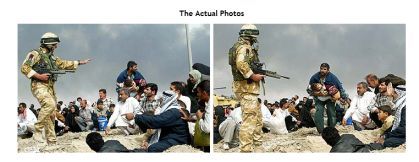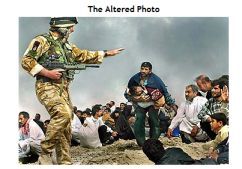Fauxtography’s alive and well in the UK. Recently, the BBC was ordered to issue an on-air apology when it failed to authenticate footage from a Bangalore sweat shop in one edition of Panorama.
Following that and Johann Hari’s apology for taking liberties with certain quotes, one commentary lays out on how easy it is for journalists — especially those covering wars and disasters — to sex up their reporting with subtle manipulation of images and sound.
I say “sex up” because some of the manipulation Martin Bell describes in this Times of London commentary (paywall) doesn’t necessarily change the reporting’s substance. But the sense of urgency conveyed is based on a lie:
The most common dishonesty lies in fiddling soundtracks. A reporter in a quiet corner of the battlefield may be tempted to incorporate sounds of gunfire from elsewhere. I have a friend, a brave and gifted engineer, who was operating the satellite feed from a war zone and knew that what he was transmitting, for an established TV news reporter, was fundamentally false. He remonstrated with the man, who told him that he was an “oily rag” — reporter-speak for a mere technician — and it was none of his business.
Another sleight of hand is visual. The reporter will be pictured at some safe distance from the action rushing across the street as if under gunfire. The sequence is then spliced into real combat footage from the sharp end. Well edited, it looks totally convincing.
Bell also notes other examples including:
- James Forlong, a Sky News journalist who used archived footage to construct a video purporting to show the HMS Splendid firing a cruise missile at Iraq in 2003. Sky News was fined; Forlong killed himself
- How one report from Haiti included four-year-old footage of riots that was better than the footage of more recent violence.
Does sexed up digital manipulation happen in the US too?
Heck yeah. Just ask LA Times editors about Brian Walski, who combined two photos of a soldier in Iraq into one compelling composite image. Walski explained why to Photo District News:
It looked good. It looked better than what I had, and I said ‘wow.’


Bell doesn’t get into the issue of Lebanese war fauxtography. Amazingly, an associate photo editor at the National Post, Zoran Bozicevic, predicted the kinds of staged photographs we noted in our 2006 Dishonest Reporter Awards — before the war even began.
Is it any wonder that Israel placed media restrictions on Gaza during Operation Cast Lead?

